Building a community tank can be a complicated business, particularly if some members of the community are going to be especially vulnerable! Shrimp are often suggested as a great way to help keep a tank clean and diverse, but finding freshwater shrimp tank mates does require a bit of careful consideration.
That’s why I’ve put together this list of the most popular and compatible species that can live with your freshwater shrimp as well as the key information that you need to know if you are going to make sure that none of your little friends end up becoming a late-night snack!
Contents
Freshwater Shrimp Tank Mates – What You Have To Know
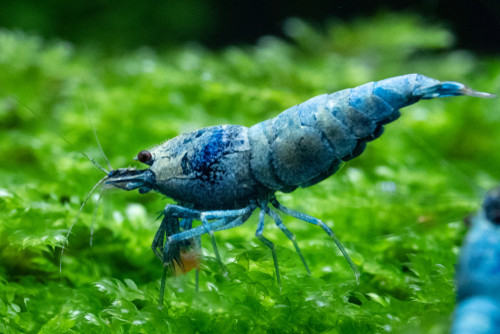
Freshwater shrimp are becoming increasingly popular additions to an aquarium because they are sweet, interesting, a little different, and very good at scavenging detritus and eating up extra algae. They are also often sold as live food for predatory fish but not everybody wants their shrimp to become a meal!
If you’re looking to create a happy and harmonious community where your shrimp can have some roommates that aren’t going to cause them harm, then you need to be pretty careful about who you introduce into the mix.
Tank Conditions and Parameters
The first things that need to be considered when you’re putting multiple species into the same space are the water parameters and tank conditions in which they will be able to thrive. There are a lot of freshwater species that will be happy in the same kind of tank and the same kind of water, but not all of them will have the same needs.
Freshwater shrimp are pretty hardy in general (although you do want ammonia and nitrates to be very low) but some species do have very specific requirements.
Ghost shrimp, Amano shrimp, Cherry shrimp, and Bamboo shrimp are happy in any non-extreme pH and alkalinity levels but Crystal and Bee shrimp need their water to have a low pH and Caridina shrimp need a higher pH and higher temperature.
Make sure to check the parameters that your exact species prefer as this will affect which other creatures can live alongside them!
Size
For any two species that are sharing the same tank, their relative size is going to be a big factor. As you can imagine, for the little shrimp in your tank this is even more important. While you would usually look for species that are around the same size for most fish, with shrimp it is all relative.
The dwarf freshwater shrimp that most people house in tanks are very tiny so they are vulnerable to almost any fish, and even the most peaceful species are known to snack on shrimp eggs and baby shrimp if they have the opportunity.
That’s why it’s key to look for fish that are also very tiny, so they don’t view your adult shrimp as potential food.
Aggression and Temperament
When it comes to shrimp, this is the most important issue to be aware of. Even fish that are primarily herbivorous and rarely hunt can take a nip at a shrimp on occasion, and this will be much more risky than if they were scrapping with another fish.
You need to find fish that are non-aggressive as well as non-predatory so that they are almost never going to interact with your shrimp at all. This will make sure that no accidents are likely to happen, even out of simple curiosity rather than hunger!
It is worth noting that almost any fish, no matter how small, may try and opportunistically snack on baby shrimp or shrimp eggs. Once they are fully grown, however, adult shrimp stop being as vulnerable.
Competition
Another very important aspect of putting a happy and diverse tank together is making sure that everybody living there gets access to what they need. This means room to move around in, specific spaces that they can enjoy, and food as well.
Fortunately, freshwater shrimp tend to match quite well with other species in this regard since they are very small and like to feed on the algae and debris that other creatures leave behind.
The most important thing to be aware of when it comes to competition is that a hungry fish will look for something new to eat. That means that even non-predatory fish might snack on shrimp eggs or babies if they are not adequately fed. Keep their tummies full and your shrimp will be a lot safer!
Ideal Freshwater Shrimp Tank Mates
So, now that you have an idea of what you should be looking for, we can start to talk about who actually might fit the bill. A lot of people will choose not to include any fish in a shrimp tank to be completely safe, and I do have some great non-fish options on this list, but there are a number of friendly, non-predatory, and relatively safe fish out there too.
Check out these other top posts in this category:
1. Other Freshwater Shrimp
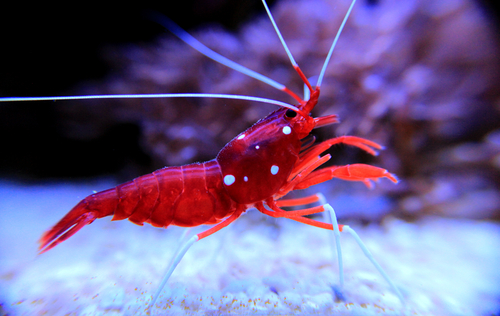
- Scientific Name: Palaemonetes paludosus, Caridina multidentate, Neocaridina heteropoda, Caridina cantonensis, Atyopsis moluccensis
- More Tank Mates: Snails, Tetras, Rasboras
- Size: Approx. 1 – 1.5 inches
- Level of Care: Easy
- Originated: Varies by species
The first tank mate that I should mention is easily the most compatible – and that is other varieties of freshwater shrimp! From Cherries to Bamboos to Amanos to Ghosts, there are a lot of different and diverse shrimp with unique looks and wonderful personalities that can really liven up your environment.
The main benefit of this is that dwarf freshwater shrimp are not aggressive towards each other and most species have very similar needs. They are all pretty active and exciting to watch, but you do need to make sure that you are providing enough food and space for every individual!
2. Aquarium Snails

- Scientific Name: Pomacea bridgesii, Pomacea diffusa
- More Tank Mates: Shrimp, Cory Catfish, Gouramis
- Size: 1 – 5 inches, depending on species
- Level of Care: Easy
- Originated: Varies by species
The next most compatible creatures that you can include would be one of the many varieties of aquarium snails that are out there. Shrimps and snails are a match made in heaven. They don’t get into disagreements and will happily live side by side in the same space without problems.
Both shrimp and snails are non-aggressive and they basically can’t cause each other any harm, and there are a lot of different snails to choose from! You could get yourself a Malaysian Trumpet Snail, a Mystery Snail, a Nerite Snail, a Rabbit Snail, a Ramshorn Snail, or any one of the many other weird and wonderful options.
3. Otocinclus Catfish
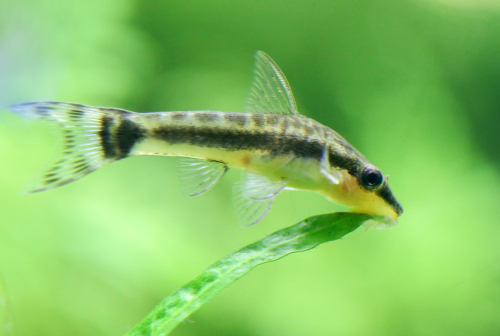
- Scientific Name: Macrotocinclus affinis
- More Tank Mates: Rasboras, Tetras, Gouramis
- Size: 1 – 1.5 inches
- Level of Care: Easy
- Originated: South America
There is something incredibly charming and adorable about how tiny these catfish are, especially compared to other catfish species. They have narrow little bodies and quite large eyes, and they are very peaceful – if a little bit nervous at times. If anything, they are going to be more afraid of your shrimp than your shrimp are of them.
There are a few different kinds of Oto Catfish out there, like the Golden, Zebra, Silver, Giant, and Alligator varieties, but they are all very harmless. They are pretty fast movers too, and they will zoom around the tank to avoid danger.
Otocinclus are algae eaters so they are one of the only aquarium fish that is considered almost completely safe to keep with shrimp, and they usually won’t even try to eat babies.
4. Chili Rasbora
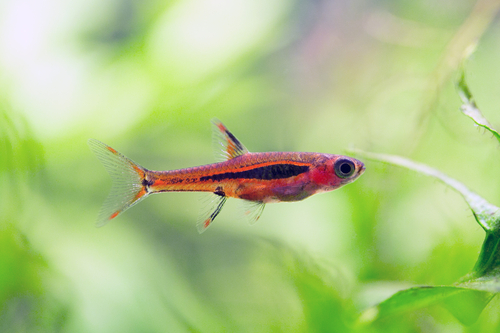
- Scientific Name: Boraras brigittae
- More Tank Mates: Tetras, Oto Catfish, Danios
- Size: Less than 1 inch
- Level of Care: Moderate
- Originated: Indonesia
There are few fish in the aquarium world that are more petite than a Chili Rasbora, which makes them an ideal option for housing with other small and vulnerable species. They are so small that they are also known as the Mosquito Rasbora!
Despite their size, these fish are brightly colored and full of life. They are very active and entertaining, and they get along really well with almost any other peaceful species. Their favorite place to be is near the upper part of the tank, so they will stay out of the way of your shrimp most of the time.
5. Thai Micro Crabs
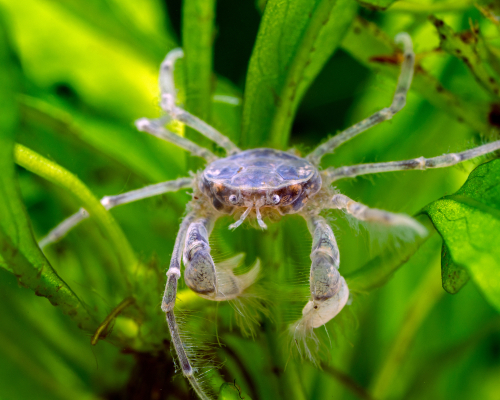
- Scientific Name: Limnopilos naiyanetri
- More Tank Mates: Shrimp, Snails, Mini Rasbora
- Size: Approx. 0.5 inches
- Level of Care: Moderate
- Originated: Thailand
These tiny little crabs are very low-maintenance and they will thrive in a variety of different conditions. While they are going to walk around on the bottom of the tank with your shrimp, they are scavengers that feed on micro-organisms and are so tiny that they are definitely not a threat.
All of these crabs originate from one river in Thailand and they were only introduced to the aquarium community relatively recently in 2008. Now, though, they are becoming very popular, particularly because they are safe to house with other tiny species.
6. Neon Tetra
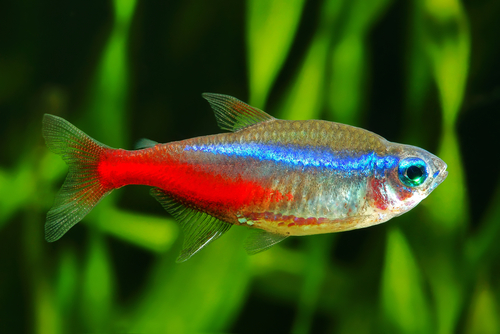
- Scientific Name: Paracheirodon innesi
- More Tank Mates: Cory Catfish, Rasboras, Mollies
- Size: Approx. 1.5 inches
- Level of Care: Easy
- Originated: South America
If you’re looking for a small and beautiful fish, then the Neon Tetra should be right at the top of that list! These little icons of the aquarium world are petite and peaceful, and adult shrimp are too large for them to view as food.
Despite their small size, Neon Tetras have become very popular due to their incredibly vibrant and eye-catching appearance, and they are an entertaining and playful species to watch as well. They can live in relatively small tanks and will spend most of their time in the middle of the water, above your shrimp.
7. Endlers (Livebearer)
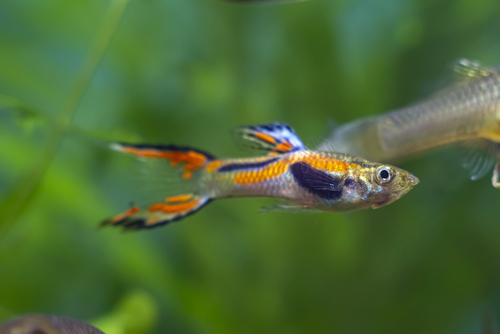
- Scientific Name: Poecilia wingei
- More Tank Mates: Cory Catfish, Tetras, Swordtails
- Size: 1 inch
- Level of Care: Easy
- Originated: South America
Endlers are another small and peaceful option that have a stunning appearance. They are well-loved in the aquarium hobby, although they are a little harder to find than some of the other fish that we have mentioned.
Because they are livebearer’s they are often mistaken as guppies, but they are really set apart by their bright colors and metallic bodies. They are generally a little smaller than common guppies as well, which means that they are less likely to try and put a young shrimp in their mouths, and adults are almost always far too large to be at any risk.
8. Cherry Barb
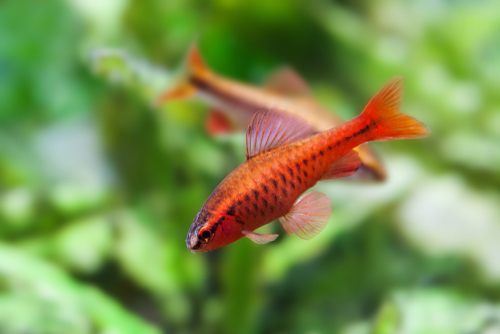
- Scientific Name: Puntius titteya
- More Tank Mates: Rasboras, Kuhli Loaches, Tetras
- Size: Up to 2 inches
- Level of Care: Easy
- Originated: Sri Lanka
Somehow even more strikingly red than Chili Rasboras, Cherry Barbs are another great option. They are a little bulkier in appearance than some of the nano species on our list and they are nice and peaceful too.
These fish do spend a bit more of their time near the bottom of the tank, and they like to have lots of places that they can sneak off to and hide. Due to their slightly larger size, Cherry Barbs may, on occasion, try to eat baby and juvenile freshwater shrimp but adults should be safe.
Selecting Tank Mates for Freshwater Shrimp
When it comes to creating a harmonious aquarium, pairing freshwater shrimp with compatible fish is crucial. Cherry shrimp, Neocaridina, and Caridina shrimp varieties are popular choices for community tanks. However, not all fish are conducive to a peaceful shrimp habitat. Here’s a guide to help you choose the best companions for your shrimp:
Compatible Tank Mates for Neocaridina Shrimp
- Neocaridina shrimp, like Cherry Shrimp, thrive with small, non-aggressive fish.
- Ideal tank mates include Ember Tetras, various Rasbora species, White Cloud Mountain Minnows, Corydoras catfish, Otocinclus catfish, and snails.
- Avoid aggressive fish, such as male Bettas, which may harm these petite shrimp.
Cherry Shrimp Tank Companions
- Cherry Shrimp’s vibrant colors make them a striking addition to any tank.
- They coexist peacefully with small schooling fish such as Ember Tetras, Galaxy Rasboras, and Chili Rasboras.
- Bottom-dwellers like Corydoras and Otocinclus catfish are also suitable, helping to keep the tank clean.
Caridina Shrimp Tank Mates
- Caridina shrimp, including Crystal Reds, have specific water needs, requiring careful selection of tank mates.
- Peaceful companions include Neocaridina shrimp, small Tetras, Pygmy Corydoras, and Amano Shrimp.
- Avoid shrimp predators, including most dwarf cichlids, and provide plenty of plants and hiding spots for these delicate shrimp.
General Guidelines for Shrimp-Friendly Fish
- Opt for small, peaceful fish that can’t consume adult shrimp, like small Tetras and Rasboras.
- Choose timid species that occupy lower tank levels and display non-aggressive behaviors towards shrimp.
By following these guidelines, you can create a tranquil and visually appealing aquarium environment where both your shrimp and fish can thrive.
Choosing Plants and Decor for Freshwater Shrimp
To keep your freshwater shrimp healthy, it’s recommended you populate the tank with suitable plants and decorations. Shrimp feel more secure with ample hiding spots and need surfaces to graze algae from.

Some of the best freshwater plants for shrimp tanks include Java Moss, Anubias, Java Fern, Duckweed, and Hornwort. These varieties provide protection, surfaces to cling to and help improve water quality.
With a well-decorated tank containing plants and hiding spots, you can create an ideal environment for shrimp. This allows them to exhibit their natural behaviors as they explore the tank and graze on algae.
Picking Freshwater Shrimp Colors
One exciting aspect of keeping freshwater shrimp is the wide range of colors and patterns available. When selecting shrimp, you can choose vibrant solid colors or go for more exotic and intricate markings.
From my experience, some of the best freshwater shrimp for stunning colors include Cherry Shrimp, Painted Fire Red Shrimp, Blue Velvet Shrimp, and Orange Eyed Blue Tigers. These varieties display intense reds, blues, and bold hues.
Whichever you prefer, it’s easy to add serious visual appeal to your tank by picking freshwater shrimp with vibrant, eye-catching colors. Just be sure to provide plenty of hiding spots so their colors continue to pop.
Summary: Ideal Tank Mates For Freshwater Shrimp
How can you decide on the ideal tank mate for freshwater shrimp? Well, it’s all about making sure that the shrimp don’t become a snack. That means you need to look for very small, non-aggressive, and non-predatory species – and even then shrimp eggs, babies, and juveniles might find themselves in a fish’s mouth.
The safest options of all are other shrimp, aquarium snails, micro crabs, and Oto catfish – but adult shrimp will almost always be able to live happily alongside well-fed and peaceful little fish like micro Rasboras and small Tetras.

JJ has had a passion for learning about aquatic life since age 5. As an adult, he made his passion a career as a certified aquaculture dealer and aquarium content creator.


